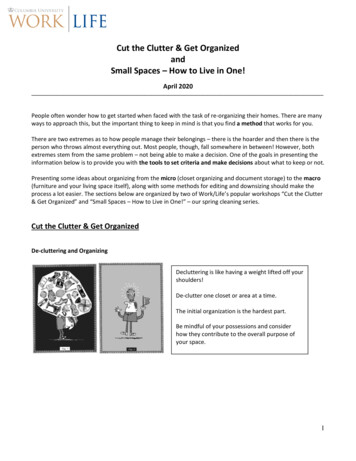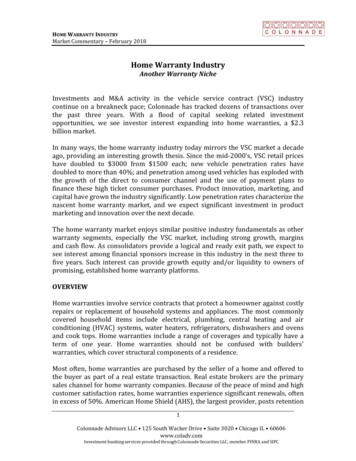
Transcription
April 2020Cut the Clutter & Get OrganizedandSmall Spaces – How to Live in One!April 2020People often wonder how to get started when faced with the task of re-organizing their homes. There are manyways to approach this, but the important thing to keep in mind is that you find a method that works for you.There are two extremes as to how people manage their belongings – there is the hoarder and then there is theperson who throws almost everything out. Most people, though, fall somewhere in between! However, bothextremes stem from the same problem – not being able to make a decision. One of the goals in presenting theinformation below is to provide you with the tools to set criteria and make decisions about what to keep or not.Presenting some ideas about organizing from the micro (closet organizing and document storage) to the macro(furniture and your living space itself), along with some methods for editing and downsizing should make theprocess a lot easier. The sections below are organized by two of Work/Life’s popular workshops “Cut the Clutter& Get Organized” and “Small Spaces – How to Live in One!” – our spring cleaning series.Cut the Clutter & Get OrganizedDe-cluttering and OrganizingDecluttering is like having a weight lifted off yourshoulders!De-clutter one closet or area at a time.The initial organization is the hardest part.Be mindful of your possessions and considerhow they contribute to the overall purpose ofyour space.1
April 2020Marie Kondo QuotesThe following quotes have been excerpted from Marie Kondo’s book, The Life Changing Magic of Tidying Up.Marie Kondo is a world-renowned Japanese organizer and creator of the philosophy – the KonMari Method. Start by discarding. Then organize your space, thoroughly, completely, in one go.” “A dramatic reorganization of the home causes correspondingly dramatic changes in lifestyleand perspective. It is life transforming.” “If you tidy up in one shot, rather than little by little, you can dramatically change your mindset.” “ we should be choosing what we want to keep, not what we want to get rid of.” “ take each item in one’s hand and ask: ‘Does this spark joy?’ If it does, keep it. If not, disposeof it.” “The point in deciding specific places to keep things is to designate a spot for every thing.” “I have only two rules: store all items of the same type in the same place and don’t scatterstorage space.” “It’s a very strange phenomenon, but when we reduce what we own and essentially ‘detox’ ourhouse, it has a detox effect on our bodies as well.”2
April 2020Step 1 - Basics: Start smallChoose an areaAllot time to organize (and it will take longer than you might think)Clean-upReview what you have accomplishedStep 2:As you go through each closet and drawer, create piles of things to: KeepDonateRecycleAnd just plain throw-out!Step 3: Gather like items together (i.e. hats, office items, outdoor attire - such as coats, and umbrellas)Purge!Everything that you keep should be assigned a homeMake things easily accessible, particularly the things you use all the timeOnce you know what you want to keep: Find appropriate storage and label the boxesUntil you know exactly what you want to keep, you might need to move things around so everything fitsproperly in closets and drawers. DO NOT BE AFRAID of this. It is part of the process.3
April 2020Storage:ClosetsThe best way to organize a closet is by taking every single thing out of it. Then go through everything, decidingwhether it is to be kept, donated, recycled, etc., before anything goes back in.For more information see “This is Your Ultimate Guide to Closet Organization” Skinny hangers make a huge difference in how much space your clothes will take up in your closet. If allyour hangers are the same style and color, everything will look more orderly.Some good hangers are Real Simple’s “Slimline”. Storage boxes for accessories and other items have a lot of options in sizes and styles. The clear plasticones allow for easy viewing. Labelling everything is the most helpful method in order to know what’sinside each box. Measure your shelving and closets very carefully so the boxes fit properly. Accessory storage – those closet door containers that you thought were just for shoes are even betterfor easy viewing and accessibility for scarves, gloves, or other small items you want in easy reach.DrawersTake every single thing out. Then go through everything, deciding whether it is being kept, donated, recycled,etc. before anything goes back in. Plastic drawer dividers can help to fully utilize and organize every inch of drawer space.4
April 2020Storage underneath the bed It’s best to have a bed that has complete storage underneath so every square inch is utilized, but if youare not ready to buy a new bedframe with built-in storage, then separate storage drawers are an option.OverstockIKEACasa KidsContainer StoreKitchen Storing food in stackable air tight containers saves space, and keeps unwanted guests away.Container StoreBed, Bath and BeyondMore kitchen storage information is available in this article.“Top Organizers Share Their 11 Best Kitchen Storage Secrets”Long-term Storage Photos and memorabilia can be stored in archival boxes on the highest shelf of a closet.If at all possible, avoid off-site storage.Off-season storage: “How to Store Your Winter Clothes”5
April 2020Maintenance Maintaining your newly organized home is very important – otherwise, you will be back to where youstarted. It doesn’t matter what system you use to keep yourself organized, just as long as you stick to itCreate a habit, such as not going to sleep unless everything has been put away.If you can’t go through all your mail on a daily basis, then set some time aside to go through all of it onthe weekend.RecyclingThe Upper West Side Recycling organization provides a very thorough list of hard-to-recycle items, such asbatteries and lighting, paper shredding, plastic, textiles, and also lists organizations that accept donated items.Many of the resources listed are applicable for any area in NYC.https://www.uwsr.org/hard-to-recycle-listThe Department of Environmental Stewardship website lists many resources. They partner with Facilities twice ayear to help Columbia departments and affiliates recycle unused or unwanted items.https://sustainable.columbia.edu/More Information“Spring Cleaning in 10 Days”“15 Affordable Furniture Brands You Need to Know Now”National Association of Productivity & Organizing Professionalshttps://www.napo.net/6
April 2020Small Spaces – and How to Live in One!Some basics: Understand the flow of the space you have and its limitations.You can downsize and live in a smaller space – eliminating things is freeing! You can be weighed downby your possessions.Choose what you live with very carefully.Living small is a way to reduce your environmental impact.Do not use off-site storage! Do you really need these things? This is usually a waste of money.Buy only what you really need.Tidy up and organize daily. This should be part of your regular routine.Take care of your home and it will take care of you (you’ll feel good!).Things to consider: De-cluttering and organizing (see the “Cut the Clutter and Get Organized” section)Scale of space / Scale of furnitureSight linesLightness / Transparency of furnitureMaximize storage / Furniture does double-dutyGo vertical / Use the wallsColor – use sparingly / Stick to neutralsLightingPlanning your spaceWhen planning your space, there are a few things you should keep in mind: Think about how you use the space and what is most Important to you.Find photos of spaces you like– Why do you like it? Are there elements you can replicate?Make a detailed list of your requirements per room.Consider the number of people living in the space and what their needs are.Consolidate items.Think about aesthetics and practicality – minimalism/order vs. clutter.Measure the space – and measure twice! Hire professionals if you need them (architect, carpenter, etc.)Make a budget and a schedule – you will go over budget and over schedule, so build in flexibility.For help in planning your room layout, Apartment Therapy has some suggestions for apps to make it easier.“The 10 Best Apps for Planning a Room Layout and Design”7
April 2020Scale of Space / Scale of FurnitureLight and neutral colors with appropriatelyscaled furniture help to expand this verynarrow space.The furniture is open and scaled properly here. Notice how the darkaccent wall helps to anchor the dining area while adding color. When everything in the apartment is nearby, you're really going to notice when something'samiss. This means that little details can make a big difference. If something about your space just seems a bit off, or if you've put everything away but yourapartment still seems inexplicably cluttered, take a look at these five details that can open up asmall space.o Shades that mount inside the window frame rather than on top of it help to adddimension to the wall and scale the windows appropriatelyo Furniture that doesn't quite touch the flooro Wall-mounted shelves in place of bookcaseso A rug that's big enough and sized appropriately for the area and spaceo Artwork that's big enough for your space Focus on highlighting key elements of your space. Create different zones within a room – a dining area, sitting area, entry area, etc.8
April 2020Sight LinesVery small space, but everything is openand visibleTranslucent screen separates entryand kitchen without losing lightCurtains that can be open or closed help to createa delineation of space without losing an openness In a small space or apartment, every area needs to be thought about. Clear and open sight lines enable your eye to continue throughout the entire space. Use curtains around the bed area that are the same as at the window.They disappear when open, but when closed they might be translucent, still providing privacybut allowing some light through them. When you first enter a room, what do you see? A translucent screen hides the kitchen orbathroom door, so seeing the apartment’s plumbing is not your first impression.9
April 2020Lightness / Transparency of Furniture Lucite – weightlessness makes it nearly invisible and doesn’t take up visual space. A shallow console table gives you some horizontal surface, and the ability to store basketsunderneath (baskets can hold hats and gloves in the winter). Air space around, above and below keeps the space open. To make a piece of furniture disappear, paint it the same color as the wall. Dark colors make the space feel smaller, which can create a particular effect, but need to beused thoughtfully, especially if there is a bulky coffee table or desk. You can remedy thatproblem by going for glass or a clear, durable plastic surface, such as Lucite. The see-throughquality will take up less visual space and make the room seem bigger, even if the coffee table isexactly the same size as your old one.10
April 2020Lightness / Transparency of Furniture(cont.) Screens or backless bookshelves can be used to delineate areas in a room and create the illusionof multiple spaces. A decorative room divider, panel, or curtain can artfully carve out different areas from one largespace. You can use a bookcase for more than just storing books. It can also separate your work spacefrom your sleeping quarters. It is not necessary to rely on walls to create "rooms”.11
April 2020Maximize Storage / Furniture that can do double-duty Consider every inch of space – not all of it needs to be actively used, as you might want toconsciously have empty “air” space. Be consistent with storage components. This helps to make the space feel more organized andless visually confusing. Multifunctional furniture might be helpful:o An ottoman could be extra seating or the coffee tableo A trunk or rectangular basket can serve as a play table, or a coffee table, and has storagefor blankets, pillows, etc. Don’t be afraid to accessorize. Filling walls, shelves, and tables with items you love willautomatically make the space inviting, cozy and personal. Be sure not to mistake clutter for accessories! Be organized and intentional with what youchoose to hang and place. When really low on storage cabinets or closets, display your possessions like art.12
April 2020Go vertical / Use the walls Do not waste vertical space. Wall space or overhead in the kitchen can be used to hang pots and pans. Shelves on the wall are not as heavy as cabinets. Monochromatic floating shelves give the rooman airy feeling and enable a tightly edited display of plates, glasses, canisters, etc. Use spaces below surfaces and above eye level. If your ceilings are high enough, build a loft area. Hang a bike from the ceiling or wall – but be sure there is proper support (beam or stud). It canlook like wall art or sculpture.13
April 2020Color – use carefully! Where are the light and dark spots in the space? Have consistency in color (neutrals) - and then add splashes (intense color). Dark colors close the room in, making it feel cozy.Light colors make it feel more open. A cheery yellow or a bright white on the walls can make a room seem much bigger. Be sure to choose accents wisely; you can opt for big color on the furniture if everything else ismonochrome and neutral. To make a piece of furniture disappear, paint it the same color as the wall so it does not registerthe bulk of the furniture.14
April 2020Lighting Overhead lights can be harsh and very limiting, as they cast a uniform glow over your space,highlighting every flaw and making the room look smaller.Use lamps that make the most of the areas that you love the most, like a reading nook or aparticular piece of artwork.Light each zone – bed, table, desk, sofa area – separately.Pick a focal point.A dramatic statement piece can be the focus of a space, big or small.Consider lighting both during the day and at night.Lighting should not just be against the walls.Three different light fixtures that accomplish different things.o Ambient light - use a patterned, focused overhead lighto Accent light - a table lamp or floor lampo Task light – a table or floor lamp, but used for readingLighting – reflected light Mirrors reflect light and expand a space.Use a large mirror in a small room – it will create an illusion of depth.Use mirrors in hallways and stairways; they help to expand the space.Be thoughtful about where you hang a mirror, as it will reflect the opposite wall. What do youwant to see reflected?15
April 2020An ExampleBeforeHere's the StoryA tiny apartment (this one is only 307 square feet) doesn't need to feel cramped. With a fewrenovations (and thoughtful furniture changes), a small space can look much roomier. There are threekey problems with this apartment.Problem No. 1: No room for furniture. The living room is a mishmash of mostly large-sized furniture,making it feel cluttered and cramped.Problem No. 2: The kitchen is an open area without any counter or storage space, and just a minifridge.Problem No. 3: The bedroom is claustrophobic with very little storage.And the difference is 16
April 2020After Color ties the entire apartment and the furniture together.Scaled-down furniture – swap out over-stuffed pieces for smaller, more tailored pieces.Floor-to-ceiling open shelving creates storage, organizes things, yet still feels open.Kitchen is uniform, with open shelving. Curtain is used to hide and separate.Table folds out for eating - when folded in it is only 12” wide.Storage is added in slide-out drawers under the bed.The sofa is floated in the middle of the space which helps to create a delineation between thekitchen and the living room, as well as utilizing the space more efficiently.17
April 2020ResourcesBooksBartolucci, Marisa. Living Large in Small Spaces. New York: Harry N. Abrams, Inc., 2003.Beta-Plus Collection. Home Series, Volume 7: Small Spaces. Belgium: Beta-Plus Publishing, 2009.Emslie, Sara. Beautifully Small: Clever Ideas for Compact Spaces. London and New York: Ryland Peters & Small, 2014. *Grayson Trulove, James. Living Big in Small Apartments. New York: Harper Design, 2005.Grayson Trulove, James. 25 Apartments and Lofts Under 2500 Square Feet. New York: Collins Design, 2006.Gauer, James. The New American Dream: Living Well in Small Homes. New York, Monacelli Press, Inc., 2004.Hellman, Anne. Design Brooklyn. New York: Stewart, Tabori & Chang, 2013.Inions, Cynthia. The Storage Book. London: Octopus Publishing Group Ltd., 1997.Kaufman, Donald and Taffy Dahl. Color: Natural Palettes for Painted Rooms. New York: Clarkson PotterPublishers, 1992.Kondo, Marie. The Life-changing Magic of Tidying Up. Berkeley, CA: Ten Speed Press, 2015. *Mahoney, Jenna. Small Apartment Hacks. Berkeley, CA: Ulysses Press, 2013. *Paredes Benitez, Cristina. 200 Small Apartment Ideas. Buffalo, NY: Firefly Books, Inc., 2002.Sanchez Vidiella, Alex. Small Apartments of the World. Buffalo, NY: Firefly Books, Inc., 2014.Tanqueray, Rebecca. Small Spaces: Making the Most of the Space You Have. London and New York: RylandPeters & Small, 2012.FurnitureNewAll ModernCB2ChairishContainer StoreCrate and BarrelDesign Within ReachDot & BoGothic Cabinet CraftJensen LewisIKEAKnossos Furniture DesignMitchell Gold Bob WilliamsMujiPier 1Resource FurnitureRoom & BoardStructubeWest ElmWest NYC www.westnyc-home.com/18
April 2020UsedHousing yo.com/thFlea Markets – 76 Street & Columbus Avenue on Sundays; Brooklyn Flea; LIC Flea; Chelsea rket/Online options:“Here’s Where to Buy the Chicest Secondhand Furniture Online”Websiteshttps://www.apartmenttherapy.com/ *https://www.domino.com/ *https://freshome.com/ *https://www.housebeautiful.com/ *https://www.marthastewart.com/ *https://www.mydomaine.com/ *https://www.realsimple.com/ *https://www.refinery29.com/en-us ** Sources19
Start by discarding. Then organize your space, thoroughly, completely, in one go. _ A dramatic reorganization of the home causes correspondingly dramatic changes in lifestyle and perspective. It is life transforming. _ If you tidy up in one shot, rather than little by little, you










